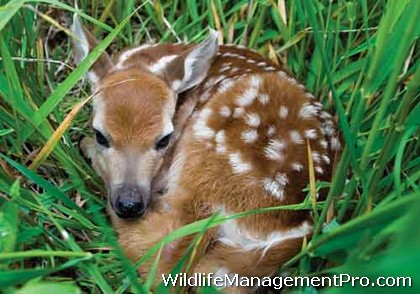The number of wild animals rises and falls based on environmental conditions. Habitat quality, namely food and cover, determines the success of individual animals to reproduce and recruit animals into the population. Many wildlife species, such as white-tailed deer and birds, are quite active throughout the year, but animals with young must work harder to find food due to increased energy demands. Young animals are often left unattended while mother looks for suitable forage. The result is that folks in rural as well as urban environments may find themselves dealing with an abandoned fawn, abandoned bird or other wildlife species.
These young or adolescent animals appear to need human kindness. More often than not, people just want to help and care for these stranded critters. Intentionally left unattended, young animals often stray and appear to be abandoned, and some may appear listless from the heat or lack of water. What you think may be happening may not be reality. Regardless of your intentions, this is not the time to lend a well-meaning hand.

In most of the white-tailed deer’s range, the fawning season begins in early to mid-May with fawns’ white-spotted and brown coats hiding them from predators. As fawns mature they shed these coats for a more adult color. As habitat conditions change and even worsen, animals will travel greater distances and take greater risks to find food and water. Because of this, many urban dwellers may spot “abandoned” fawns, birds, turtles and other wildlife in their daily walk to the car or office.
It’s common for many folks to “find” apparently lost or abandoned fawns and other young wildlife and take them in, thinking they are doing the right thing, but this typically does more harm than good. Concerned citizens should leave young animals alone unless they are obviously injured or orphaned. It is best to observe any wildlife species from a distance for a while in order to make that determination. This could take as much as 24 hours.
Staying too close to the “orphaned” animal will likely keep mamma from returning, creating a pre-determined outcome. I know that the compulsion to aid or investigate an apparently stranded little animal can be overwhelming, but in doing so you could harm its chances of rejoining its parent. If an animal is adopted, even for a few days, animals may lose the skills necessary to fend for themselves in the wild.
When most folks find an abandoned fawn they immediately think, “What should I do?” The fact of the matter is that wild animals have been making it just fine by themselves for many, many years. Removing a wild animal such as a fawn or bird from the field will often do more harm than good. Not only will the animal be abducted from its mother and from a wild life, but it alarms the animal. Many times, young animals will die from the stress created by people capturing, handling and retaining them. It’s best to just leave them alone.
As of May 31, we saved a fawn out of the jaws of a fox, turned him loose 3 weeks ago. Now he hangs around our farm. Comes out to eat morning and late afternoon, but the mosquitoes are eating him alive. I try to keep the ticks picked off, but here lately he has been covered. Is there anything I can do for him?